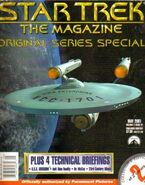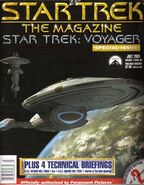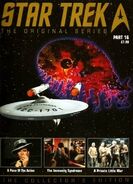Robert "Rob" Bonchune (born 15 September 1970; age 54) is a digital effects expert who worked on the Star Trek productions, Star Trek: Deep Space Nine, Star Trek: Voyager and Star Trek: Enterprise while in the employ of consecutively, Foundation Imaging, and Eden FX, after the former went out of business in 2002. He became the Senior CGI Supervisor for the last seven years of the Star Trek franchise's Berman-era television run, at first serving alongside and subsequently succeeding colleague Adam "Mojo" Lebowitz, after the latter opted not to follow his co-workers into the employ of Eden FX. No other CG Supervisor had the distinction (or workload) of serving for that period of time in that position in the franchise's history. Rob Bonchune was also part of the team that worked on the Star Trek: The Motion Picture (The Director's Edition) DVD.
Bonchune shared Emmy Awards for his CGI work on the Voyager episodes "Dark Frontier" and "Endgame" and the Enterprise pilot, "Broken Bow" with his team as the "CG Supervisor". He also received an additional three Emmy nominations for his CG Supervision on VOY: "Timeless", DS9: "What You Leave Behind", and ENT: "Dead Stop".
The Nebula-class vessel USS Bonchune was named after him, and its registry number (NCC-70915) is a play on his birth date. Bonchune created the CGI version of the ship for Voyager's episode "Message in a Bottle". (source)
Bonchune's very first brush with the official Star Trek-franchise was rather an inconspicuous one, when he was tasked in 1994 as one of the most junior employees at WonderWorks Inc. to deliver the Kazon fighter studio model to the regular Star Trek motion control stage at Image G. There, he handed the model over to Dan Curry, the designer of the ship, who wanted to make improvements to it. Curry therefore asked Bonchune to stay behind to help him distress the painting. Bonchune was thrilled to help paint the ship but figured he would likely have no more involvement with Star Trek, though fate intervened to prove him wrong. (Star Trek: The Official Starships Collection, issue 44, pp. 14-15) Two years later, Foundation in whose employment Bonchune now was, started its association with the Star Trek television franchise with Voyager, marking the start of Bonchune's nine year involvement with the live-action franchise as digital effects expert.
Bonchune, an Star Trek: The Original Series fan, was one of many production staffers who got increasingly frustrated with the chosen visual direction of the producers, while working on Star Trek: Enterprise, which started with the incident surrounding the design of Vorok's battle cruiser in the 2001 Enterprise episode "Unexpected". Eight years later, Bonchune's disappointment over that issue had not yet abated by 2009, "We all loved it over at Foundation and our friend Koji [Kuramura] built it for free. Amazingly, even though it was a freebee for the episode, certain people in production still found a way to nit pick certain things and refused to ultimately use it until windows were added in certain places. We refused, on principle, as Koji had not slept for days building that on his own and they knew it…so instead of using it, because of, I think 5 windows that you would never see, we ended up using the K’tinga, which was UTTERLY out of place and out of continuity in the "Enterprise" era," [1] having added six years later, "I am very saddened by that decision as a fan, because I knew it would ruin continuity, but considering the generous and passionate work Koji did overbuilding in quality a key Klingon ship for free, and then to not even give him a thank you and instead complain and ask for 5 more windows, we could not ask him or anyone to stay late again to change this, so we had to decline and let them go with there original plan. That decision speaks for itself."[1]
He did, for a number of years, continue to be one of the more outspoken critics – usually under his alias "nx01Rob" – in that respect on several blogs, such as TrekBBS.com and Hobbytalk.com, and as was evidenced by his comment on yet another blog, regarding the decision to remove the bird-of prey graphic from the Romulan Bird-of-Prey (22nd century) in Enterprise's episode "Minefield", "Oh and as for the BOP drawing underneath, it was rejected for no other reason than, once again, contempt for the Trek, the fans and the Original Series by…uh."management"…you know who they are. ;-)" – adding even more acidly on a later occasion, "Ahhh Producers.....you showed those fans who's boss didn't ya?" [2]
Despite these incidents occurring, Bonchune loved working on the show and got along well with his co-workers and his effects supervisors at Paramount Television in the post-production department, stating, "Mitch Suskin, Dan Curry and others where just a great group of truly caring, intelligent, reasonable and fun people to work with. The level of love for the product and the show was evident from every department really. Everyone did there best to make good Star Trek because most where fans as well."
In 1999, while he was still working on the television series, Bonchune, together with Foundation co-worker "Mojo" Lebowitz, conceived the concept of the successful Star Trek: Ships of the Line calendar series, on which he served as co-editor and co-illustrator for the first three outings. With Lebowitz he also wrote and illustrated the Star Trek: Starship Spotter reference book. Unlike his colleague though, Bonchune did not withdraw from the calendar series after the editorial conflict the series creators had with the publisher's editor-in-chief Margaret Clark, and continued to submit entries for awhile after the 2003 edition as a co-illustrator only.
Once done with the Star Trek series and after moving on to the other projects listed below, he has continued working on various Star Trek related projects. Bonchune's longstanding affiliation and love of starship design is what kept him taking any and all opportunity to work on these as long as it did not conflict with other work. Most notably were his renderings of the beauty and orthographic views of most of the Star Trek CGI ships for Paramount Publicity, in particular for the British publication Star Trek Fact Files and its American derivative Star Trek: The Magazine. Published by GE Fabbri and its US subsidiary, then Files/Magazine editor-in-chief, Ben Robinson, recalled how he approached Bonchune for the publication, "When we were first doing the Fact Files they were just introducing CG on the show and I realized it was an incredible resource for any publication. If you've got a CG model you can look at something in real detail. We approached Foundation and Eden FX about getting people to render CG models out for us. Rob was one of the guys who really took that on and we became good friends, so when I started on this project he was one of the first people I thought of. There’s no substitute for a good render of a starship. It's as close as to the real thing as you could ever get." [3] Bonchune continued afterwards to contribute to the later, subsequent Fabbri derivative partwork publications, mostly as magazine cover artist.
Robinson again contacted Bonchune several years layer to do the CGI renderings for the Haynes reference book, USS Enterprise Owners' Workshop Manual. He continued doing illustrations and building ships for Robinson to this very day on consecutive projects, a number of them not marketed in the US. Most of Bonchune's Paramount Publicity renderings of the CGI models, built by Pierre Drolet (who, incidentally, was hired by Bonchune in 1999 to work at Foundation Imaging), Brandon MacDougall, Koji Kuramura, as well as by Bonchune himself, could be found on the DrexFiles(X) blog, often uncredited and mistaken for Doug Drexler's work due to the way Drexler labeled the images on his site.
Bonchune, together with "Mojo" Lebowitz, would later join Ben Robinson's Star Trek: The Official Starships Collection partwork magazine to supervise the rendering of CGI models and the creation of new ones, if pre-existing production-used CGI models were not available. These new CG models were used for the construction of starship miniatures included with the publication.
Career outside Star Trek[]
Hailing from Montreal, Canada, Bonchune moved after graduating college to Los Angeles in order "to change his view", according to his mini biography in Starship Spotter. He first worked as a physical studio model maker for television and movies (even as late as 1995 when he contributed as such to Apollo 13, albeit uncredited), before an opening presented itself on seaQuest DSV at Amblin Imaging, where he taught himself the craft of CGI modeling, subsequently moving on, before Amblin's involvement with Star Trek, and, after his short-lived stint at WonderWorks Inc. as model maker, to Foundation Imaging.
As digital artist at Foundation he worked on Babylon 5, as well as The Jackal (1997). After his tenure on the Star Trek franchise, he worked on the television series Surface, which won him a Visual Effects Society Awards nomination in 2006 (shared with Eric Hance, John Teska and Sean Jackson), before quitting Eden FX and joining Zoic Studios (reuniting him with a host of former Star Trek digital effects artists) to work on Ronald D. Moore's Battlestar Galactica and its follow-up Caprica.
In 2011, he joined Pixomondo Visual Effects, an international VFX house that also employed several former Star Trek visual effects staffers after the live-action television franchise went defunct for the time being. While there, he worked as the senior CGI animator on Hawaii Five-O (2011), Terra Nova (2011), and Perception (2012).
Star Trek contributions[]
CGI work with:
- Star Trek: The Motion Picture
- USS Enterprise (NCC-1701): Secondary hull, pylons, neck and engines for Star Trek: The Motion Picture (The Director's Edition)
- DS9:
- USS Enterprise (NCC-1701-D): remapping and upgrading of lights
- VOY:
- Class 2 shuttle: nurnies
- USS Voyager: remapping
- Delta Flyer: Complete build
- Nebula-class: Complete build
- Aeroshuttle: Complete build
- Aeroshuttle Bay: Complete build
- USS Rhode Island: All modifications from the original USS Equinox
- ENT:
- Columbia NX-02: remap
He was also responsible for many planets, props, anomalies and the majority of the astrometrics 3D graphics. His other contributions include many texture tweaks and painting on ships during filming.
Emmy Awards[]
Bonchune received the following Emmy Award wins and nominations in the category Outstanding Special Visual Effects for a Series:
- 1999 Emmy Award win for "Dark Frontier", shared with Adam "Mojo" Lebowitz, Elizabeth Castro, Arthur J. Codron, Dan Curry, Don Greenberg, Paul Hill, Ronald B. Moore, Mitch Suskin, Greg Rainoff, and John Teska
- 1999 Emmy Award nomination for "What You Leave Behind", shared with David Lombardi, Kevin P. Bouchez, Adam Howard, Greg Rainoff, Adam Buckner, Arthur J. Codron, Judy Elkins, Dan Curry, Steve Fong, Don Greenberg, Paul Hill, Davy T. Nethercutt, Sherry Hitch, Gary Hutzel, David Stipes, Paul Maples, Gary Monak, and Larry Younger
- 1999 Emmy Award nomination for "Timeless", shared with John Allardice, Eric Chauvin, Arthur J. Codron, Dan Curry, Don Greenberg, Sherry Hitch, Greg Rainoff, Mitch Suskin, John Teska, and Ron Thornton
- 2001 Emmy Award win for "Dark Frontier", shared with Eric Chauvin, Arthur Codron, Greg Rainoff, and John Teska
- 2002 Emmy Award win for "Broken Bow", shared with Dave Morton, Elizabeth Castro, Arthur Codron, Dan Curry, Steven Fong, Paul Hill, Ronald B. Moore, and Gregory Rainoff
- 2003 Emmy Award nomination for "Dead Stop", shared with Arthur Codron, Pierre Drolet, Steve Fong, Koji Kuramura, Sean Scott, John Teska, Greg Rainoff, and Mitch Suskin
Bibliography[]
- GE Fabbri/Fabbri Publishing (US)/De Agostini (partwork) publications:
- Star Trek Fact Files, 1997-2002 – Co-illustrator, Cover Artist
- Star Trek: The Magazine, 1999-2003 – Co-illustrator, Cover Artist
- Star Trek: The Collector's Edition, 2004-2006 – Co-illustrator, Cover Artist
- Star Trek: The Original Series - The Collector's Edition 2007-2008 – Co-illustrator, Cover Artist
- The Official Star Trek The Next Generation: Build the USS Enterprise NCC-1701-D, 2011, Cover Artist
- Sci-Fi & Fantasy Models (International)
- "Building and Refitting Starships", issue 32, September 1998, p. 54 – Author
- "Creating fifth season FX for Star Trek: Voyager", issue 41, October 1999, pp. 25-26 – Author
- Star Trek: Starship Spotter, 2001 – Co-illustrator/Co-author
- Star Trek: Ships Of The Line, Calendar series, 2001-2003, Co-editor/Co-illustrator
- USS Enterprise Owners' Workshop Manual, 2010 – Co-illustrator
- Eaglemoss Collections (partwork) publications:
- Star Trek: The Official Starships Collection, 2013-2022, Co-editor/Co-illustrator
- Star Trek: Shipyards - Starfleet Ships 2151-2293, 2018 – Co-Illustrator, Digital Modeler
- Star Trek: Shipyards - Starfleet Ships 2294 to the Future, 2018 – Co-Illustrator, Digital Modeler
- Star Trek: Shipyards - Klingon Fleet, 2019 – Co-Illustrator, Digital Modeler
- Star Trek: Shipyards - Federation Members, 2019 – Co-Illustrator, Digital Modeler
Star Trek interviews[]
- VOY Season 4 DVD special feature "Red Alert: Amazing Visual Effects", interviewed on 21 April 2004
- VOY Season 6 DVD special feature "Red Alert: Amazing Visual Effects", interviewed on 21 April 2004
- ENT Season 4 DVD special feature "Visual Effects Magic"
- "Robert Bonchune", Ben Robinson, Star Trek: The Official Starships Collection, issue 44, April 2015, pp. 14-17
Footenote[]
- ↑ The later quote is ostensibly added by Bonchune himself as User:172.251.23.245 in a 2 June 2013 edit session, which includes all other edits on that date as well.
External links[]
- RobertBonchune.com(X) – archived official site
- Robert Bonchune at the Internet Movie Database
- Robert Bonchune at ArtStation.com
- Robert Bunchune Portfolio at WordPress.com
- Robert Bonchune at LinkedIn.com











